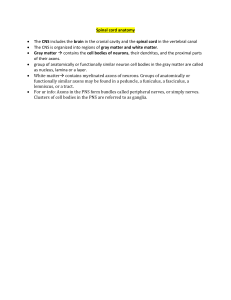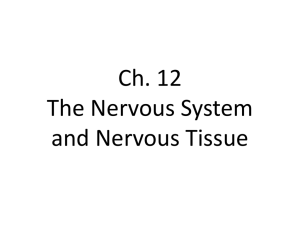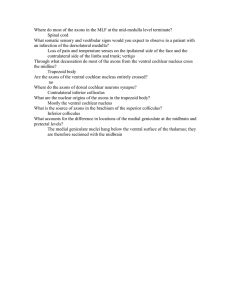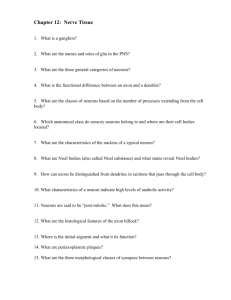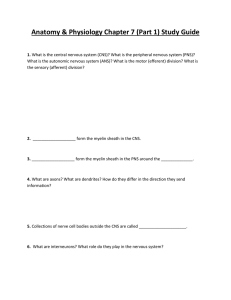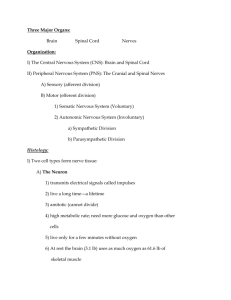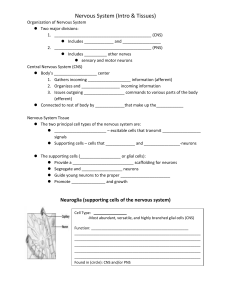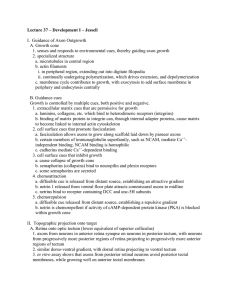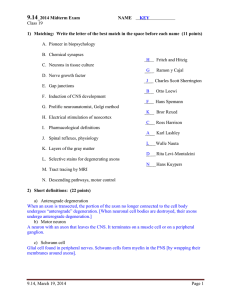Chapter 7. The Structure of the Nervous System
advertisement
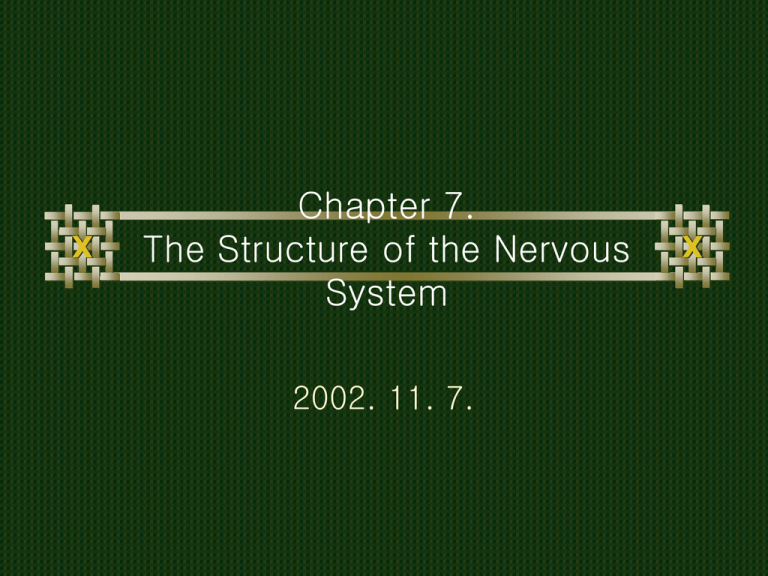
Chapter 7. The Structure of the Nervous System 2002. 11. 7. Ⅰ. Introduction General organization of the mammalian brain and the terms 3D structure of the developing brain Understanding of Cerebral neo-cortex Term1: Collection of Neurons NAME DESCRIPTION GRAY MATTER A generic term for a collection of neuronal cell bodies in the CNS CORTEX Any collection of neurons that form a thin sheet, usually at the brain’s surface NUCLEUS A clearly distinguishable mass of neurons, usually deep in the brain SUBSTANTIA A group of related neurons deep within the brain, usually with less distinct borders than those of nuclei LOCUS A small, well-defined group of cells. GANGLION A collection of neurons in the PNS Term 2: Collection of Axons NAME DESCRIPTION NERVE A bundle of axons in the PNS WHITE MATTER A generic term for a collection of CNS axons TRACT A collection of CNS axons having a common site of origin and a common destination BUNDLE A collection of axons that run together but that do not necessarily have the same origin and destination CAPSULE A collection of axons that connect the cerebrum with the brain stem COMMISSURE Any collection of axons that connect on side of the brain with the other side LEMNISCUS A tract that meanders through the brain like a ribbon. Ⅱ. Gross organization of the Mammalian Nervous System 1, Anatomical direction 2. Anatomical plane of section 3.Central nervous System RAT Human 4. The Peripheral Nervous System The Somatic PNS 1)The somatic motor axon 2) The somatic sensory axon afferent The Visceral PNS 1) 2) Visceral sensory axons Visceral motor fibers Afferent & Efferent Axon efferent 5. The Cranial Nerves Trochlear: movement of eye Trigeminal : touch to the face, mastication muscle movement Abducens: movement of the eye Glossopharyngeal: throat, salivary glands control, 1/3 tongue sensation Vagus: heart, lungs, control, throat muscle change detection, viscera pain sensation Spinal accessory: throat and neck muscles movement Hypoglossal: tongue movement p234, 235 6. The Meninges 1)dura mater 2) arachnoid membrane 3) pia mater 7. The ventricular System Fluid-filled caverns & canal 8. Imaging the Living Brain (1) Computed Tomography (CT) (2) Magnetic Resonance Imaging (MRI) 종양 3) Functional Brain Imaging- fMRI 3) Functional Brain Imaging- PET Ⅲ. Understanding CNS Structure Through Development 1. Formation of the Neural Tube 2. Three Primary/Secondary Brain Vesicles 1) Primary brain vesicles 2) Secondary brain vesicles 3) Differentiation of the Telencephalon and diencephalon Superior colliculus inferior colliculus 3. Differentiation of the forebrain 1) Differenciation of the Telecephalon and Diencephalon Coronal section Gray matter Ventricles White matter 2) Forebrain structure-function relationship Forebrain: 지각, 의식적 자각, 수의적 행동 Cerebral cortex Thalamus Cortical neurons hypothalamus 4. Differentiation of the midbrain Midbrain structurefunction relationship :감각체계, 운동 통제 : Tectum -> superior colliculus -> Inferior colliculus : tegmentum 5. Differentiation of the Hindbrain *hindbrain structure-function relationship (cerebellum, pons, medulla) 6. Differentiation of the Spinal Cord Dorsal horn cell Ventral horn cell Intermediate cell 7. Special Features of the Human CNS 유사점 차이점: 인간 대뇌의 많은 주름. Olfactory bulb가 쥐가 더 큼. 인간 뇌의 lobe의 구분 Cerebral Cortex The lobe of the human cerebrum Brodmann’s cytoarchitectural map Ⅳ. Guide to the Cerebral Cortex Neo-cortex evolution and structure-function relationships Primary sensory area Secondary sensory area Motor area Associate area-’mind’ http://eye.snu.ac.kr/ 7장 강의 자료 & 기타 사항 공지
